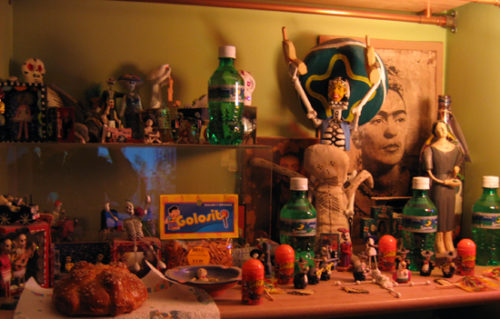PORTLAND, Ore. – Stumbling across a spontaneous shrine is a common experience in the United States. It may be a cross on the side of the road marking the place where a loved one died in a car accident, or a photos, card, and flowers stuck in the links of a fence where a recently passed celebrity lived. Throughout history, humans have created these shrines to remember and reconnect with the dead.
On Sunday, Alley Valkyrie passed a sidewalk shrine that was very similar, yet very different, than most spontaneously created shrines. This one, created by persons currently homeless, was to honor and thank the living, not the dead.

[Courtesy A. Valkyrie]
The shrine was created by three men who live together as a group and refer to each other as family. The shrine is on a sidewalk, a block away from a Safeway in a wealthy neighborhood. It is a secular shrine but, as some experts might say, it has a wealth of spiritual meaning built into it.
One of the men, named ZKAH, told Ms. Valkyrie that they built the shrine to reflect and acknowledge how much people in the neighborhood are caring for them and helping them. ZKAH said, “We can’t survive without our brothers helping us out and we want to show that.”
Universality of Shrines
At first glance, the items left as an offering have some superficial elements in common with African diaspora spiritual systems such as what are commonly called Santeria and Voodoo. There is tobacco, alcohol, and food. Yet Carlos Muñoz, an initiate in Olorisha in La Regla de Ocha, says there is a glaring difference. In Santeria, there would be a statue of the Orichás being honored and the statue is the materially present divine spirit, not a representation. “When we make an offering, will there be food? Yes. Will there be alcohol? Sure. In this [shrine], some elements are there, but context is everything. The context is not Santeria.”
Editorial Note (MJTM: 6/17/2020): Mr. Muñoz is an initiated priest of Ochun in Regla de Ocha. Mr. Muñoz clarified that “in the Lucumí religion, (Santeria, pejoratively known to outsiders), the sacred representations, objects, implements, and tools of the Orichas are honored and the animistic presence of theses deities/ forces of nature are ever present in them.” Mr. Muñoz added that the “context in this shrine is not comparable in Regla de Ocha, as this shrine is neither to Eggun/Araorun (ancestors/spiritual guides) or the Orichas.”
Mr. Muñoz did see a common ethic behind the offerings in this secular shrine to living benefactors and a traditional offering to the Orichás or ancestors, “It’s similar in that it’s a thank you for help and sustenance.” He says that he gives to deities because they give back to him. He sees a similar impulse in the secular shrine created by ZKAH and his family.
Editorial Note (MJTM: 6/17/2020): Mr. Muñoz clarified the above statement and quotation. The quotation should read “he gives to the spirits and deities because they give back to him.”
Rev. Kevin Marquardt Bradley, an interfaith counselor, hospice Chaplain, and Daoist says even though American culture separates the physical and the spiritual, we continue to find ways to bring them together through rituals such as building spontaneous shrines. “This creates community and a common identity,” Rev. Bradley says. This is why humans, as he explains, have engaged in shrine building through every era in every culture and religion.
Bradley said that this particular shrine isn’t trivial, but rather complex and full of meaning. “This is a celebration of life. They are parting with things that are very valuable to them. Look at how the fresh vegetables are center. The hand warmers, which are like gold. Life giving items and they’re sharing them.”
Rev. Bradley went on to say that one of the themes in most world religions is that those who have the least and still give to others, are closer to enlightenment.“It’s the parable of the Widow’s Mite.”
Both Muñoz and Bradley thought the shrine reminded them of Day of the Dead offerings. “The placement is reminiscent of Day of the Dead altars or Reclaiming altars you see in San Francisco for the honored dead,” says Muñoz. Bradley says Day of the Dead altars aren’t as much about remembering the dead but about maintaining a connection to them. He believes that this could be the feeling behind this shrine, to stay connected in a positive way by giving back things they believe others would appreciate.

Day of the Dead shrine created by the boy friend of a murdered young woman [Credit: Drew Crecente / Wikimedia]
Dr. Angela Brakstone, a sociologist specializing in religion, says persons who are homeless are living on the edges of our society. A liminal population who are treated, in some ways, as if they are already spirits. “They are present all around us and yet aren’t seen. Just as it’s a taboo for the living to look upon the dead, we don’t make eye contact with homeless persons.”
In her 2014 essay Invisible Among Us, Valkyrie discusses this very issue, in relation to her own lived experience. “I walked past another corner and saw a homeless beggar sitting in a doorway, an older man that I realized that I had walked by dozens of times before, and yet I had never actually seen him. I stood there, staring at him, processing what I had experienced in the past three days. I realized that not only did this man experience that same invisibility every single day, but for him it was a fixed condition, not something that ended when the work day was over.”
The reason, as Dr. Brakstone speculates, for people not wanting to interact with homeless persons is the same reason humans generally don’t want direct experiences with spirits – magical contagion. Magical contagion is the belief that a person’s essence or status can be transmitted through objects or by being in proximity to the person. Dr. Brakstone says it is logical to not want to be homeless or dead. It is not logical, yet common, to believe you can become homeless or dead through simple eye contact.
Brakstone adds that this shrine is an attempt to remind people that this family is still very much within the community and flips the normal paradigm around. “Usually, a shrine is for the living to communicate with the dead. To thank them or ask them for help,” she says.
“This shrine is the living attempting to communicate with the living.”
CORRECTION 3:22 pm 1/10/17: The shrine is located in Portland, Oregon. The original article said Eugene, Oregon.
CORRECTION 6/17/20 (MJTM): Mr. Carlos Muñoz’s name has been updated with appropriate spelling.
The Wild Hunt is not responsible for links to external content.
To join a conversation on this post:
Visit our The Wild Hunt subreddit! Point your favorite browser to https://www.reddit.com/r/The_Wild_Hunt_News/, then click “JOIN”. Make sure to click the bell, too, to be notified of new articles posted to our subreddit.
A ‘shrine’ prominently featuring large empty liquor bottles is highly unlikely to impress anyone as anything but a blight and hazard to the neighborhood that needs to be dealt with by law enforcement.
well, you’re a bundle of empathy and understanding aren’t you?
He does have a point. If I saw that I’d be more than a little nervous. Granted, they probably don’t have much to offer, but it’s telling that there are more liquor bottles there than anything else.
I have plenty of empathy and understanding for the people who live in the neighborhood not being forced to see piles of trash consisting potentially hazardous items like glass bottles which can be easily broken and cause a danger to them, their children and pets. The same goes for rotting malodorous food items which draw vermin like rats, mice and pigeons to the place where they live.
I think we should keep in mind that it is significantly easier to add a solid bottle to an outdoor “shrine” than trying to find a way to keep a handful of empty food wrappers from blowing away. Either way, many would consider them trash or littering.